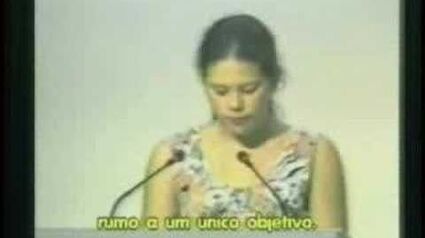The United Nations Conference on Environment and Development, also known as the Earth Summit (or, in Portuguese, Eco '92) was a major conference held in Rio de Janeiro from June 3 to June 14, 1992.
178 governments participated, with 118 sending their heads of state or government.[1] Some 2,400 representatives of non-governmental organizations (NGOs) attended, with 17,000 people at the parallel NGO Forum, who had so-called Consultative Status.
The issues addressed included:
- systematic scrutiny of patterns of production — particularly the production of toxic components, such as lead in gasoline, or poisonous waste
- alternative sources of energy to replace the use of fossil fuels which are linked to global climate change
- new reliance on public transportation systems in order to reduce vehicle emissions, congestion in cities and the health problems caused by polluted air and smog
- the growing scarcity of water
An important achievement was an agreement on the Climate Change Convention which in turn led to the Kyoto Protocol. Another was agreement to "not carry out any activities on the lands of indigenous peoples that would cause environmental degradation or that would be culturally inappropriate".
The Convention on Biological Diversity was opened for signature at the Earth Summit, and made a start towards redefinition of money supply measures that did not inherently encourage destruction of natural ecoregions and so-called uneconomic growth.
Twelve cities were also honoured by the Local Government Honours Award for innovative local environmental programs. These included Sudbury, Ontario in Canada for its ambitious program to rehabilitate environmental damage from the local mining industry, Austin, Texas in the United States for its green building strategy, and Kitakyushu in Japan for incorporating an international education and training component into its municipal pollution control program.
The Earth Summit resulted in the following documents:
- Rio Declaration on Environment and Development [1]
- Agenda 21 [2], [3]
- Convention on Biological Diversity [4]
- Forest Principles
- Framework Convention on Climate Change
Both Convention on Biological Diversity and Framework Convention on Climate Change were set as legally binding agreements.
Critics, however, point out that many of the agreements made in Rio have not been realized regarding such fundamental issues as fighting poverty and cleaning up the environment.
Village cinema[]
Commission for Sustainable Development[]
CSD has served as the UN high-level forum for sustainable development issues since 1992, when it was established by the UN General Assembly to ensure effective follow-up to the United Nations Conference on Environment and Development, known as the Earth Summit, held in Rio de Janeiro. CSD meets annually at UN Headquarters; its focus themes for 2006/2007 are energy for sustainable development, industrial development, air pollution/atmosphere and climate change.
Related[]
|
Agenda 21 W
|
|
Resources -
Portal - Inspiring quotes - Images - Village cinema - Random facts - Sustpedia - Department of FUN! - ![]() Village pump
Village pump
SCA Wiki - Places, projects & networks - Ideas Bank - News - Diary - Resources - Community / Avoid adverts
| This page uses Creative Commons Licensed content from Wikipedia (view authors). |
References
- ↑ Keith Schneider, "White House Snubs U.S. Envoy's Plea to Sign Rio Treaty," New York Times, 5 June 1992; James Brooke, "U.N. Chief Closes Summit With an Appeal for Action," New York Times, 15 June 1992

